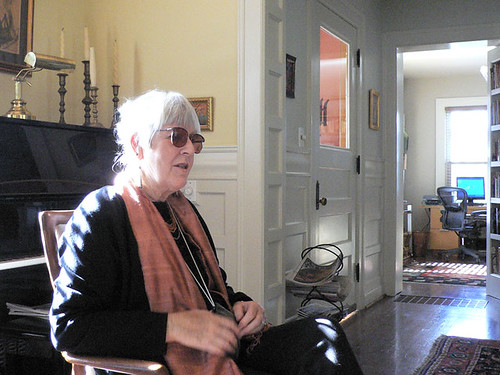In 1957, a 23-year-old Joanne Kyger arrived in
A cornucopia at just under 800 pages, About Now appears to me to pretty much collect everything outside of the Japan & India journals. More than any previous volume, About Now makes evident the why of Joanne Kyger’s extraordinary impact. What is it about her writing that has proved so fruitful for so many different kinds of poetry? The answer is so very simple that Kyger announces it, literally, in the book’s title. To a degree perhaps matched only by the late Larry Eigner, Joanne Kyger is a master of the poem that what records whatever happens to be taking place right now. It’s a literary strategy that fits perfectly the Buddhist path that Kyger has taken ever since that first trip to
Bird family
boat going out to sea
all this
every day
Those last two lines turn out to be the title of one of Kyger’s earlier books, published by Bill Berkson’s Big Sky press back in 1975. Like the current volume, many of Kyger’s books propose a focus on just looking at what’s really there – Joanne; Trip Out and Fall Back; The Wonderful Focus of You; Going On (Kyger’s first big selected, published by Dutton some 24 years ago); Some Life; Again; As Ever – that it seems no accident that Kyger’s volume in the Charles Olson-inspired Curriculum of the Soul series, the topic she was assigned, turns out to be Phenomenological.
A second dimension, as important as the first (and something much more active in Kyger than, say, Eigner), is humor. Kyger’s not afraid of jokes, even when they take up the whole poem:
Love
When people say they love me I tell them
Give me a loaf of bread – I loaf you!
Humor is precisely the dimension that invests depiction (& its kin description²) with personality. What Phil Whalen once characterized quite accurately as a “continuous nerve movie,” poetry without personality is rather a dull lens indeed. Consider what that cornball pun above brings to a simple equation of love with giving with the staple of bread – it invests everything with a sense of play & with goodwill. It offers boundless energy as well as a sense of forgiveness – you can be a complete dodo the people who really love you actually do. Vulnerability here is not risk. This isn’t a bad portrait of love at all in spite of all its silliness. Perhaps I should say because of all its silliness.
About Now chronicles nearly one half century of American poetry using just such simple tactics. While there are poems here that tell tales & some go on for pages (there are a couple even that border on becoming novels in the sense that Jack Spicer’s Heads of the Town Up To the Aether might be called a novel), Kyger’s exactness of vision remains her strong suit however she thinks to employ it. Consider the use of nouns & noun phrases in this three-line poem from 1995, how the first one hovers between cliché & description (that divide is, in a sense, the whole point), the second is a noun phrase that announces itself as metaphor, while the third – the door – is so matter-of-factly utilitarian & depictive that it snaps the other two into place. At least until you realize just how much of a metaphor sans ground it is as well:
The storm is upon us
Where is the wand of unawareness
Did I throw it out the door last night?
About Now is a volume on a scale with, say, the Collected Poems of Ted Berrigan. If you own one, you really ought to own both, alongside of course comparable volumes from Ginsberg, Whalen, Creeley, the forthcoming Jack Spicer collected, etc. The poetry of Joanne Kyger is not only vital for an historical understanding how all these different kinds of writing fit together, it is one of the shining monuments of a generation that has given us an extraordinary amount of pleasure. Who wouldn’t want to sip from this stream?
¹ Three of them close personal friends of Robert Duncan.
² The differences between which are worth thinking about, particularly if considered in moderately literal terms.






